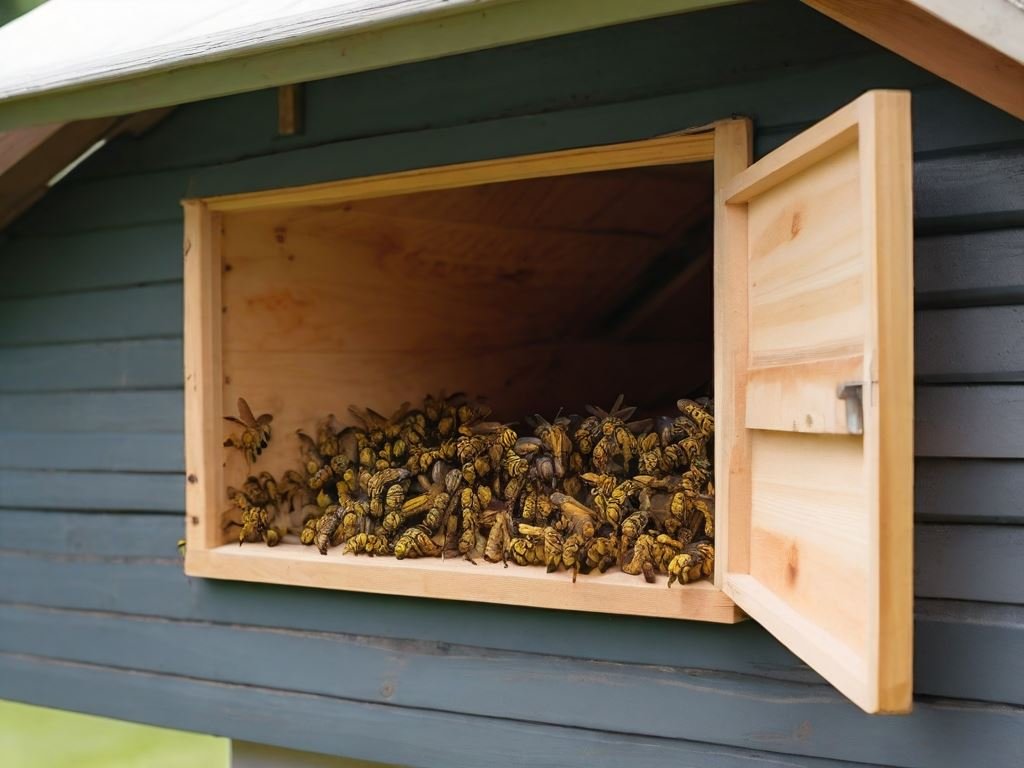Your shed, once a haven for equipment and possessions, is now infested with swarming wasps.
Fear not, as we continue on lengthy trips to find subtle and successful methods for repelling these stinging visitors.
Wasps, with their distinctive buzzing and occasionally aggressive behavior, can change your shed from a refuge of storage into a source of anxiety.
In this complete blog, we will look at the range of full strategies, including how to keep wasps out of shed.
Whether you’re dealing with an existing infestation or trying to prevent one, these thorough remedies can help you regain your shed space and provide a safe and enjoyable atmosphere.
Identifying Potential Entry Points
Secure your storage shed with professional advice on how to keep wasps out of storage shed, resulting in a hassle-free and neat place.
Begin your protection by thoroughly evaluating your shed for any entrance points. Wasps may exploit even the slightest openings or cracks in the structure.
Pay particular attention to the windows, doors, vents, and seams. Seal these possible access spots using high-quality seals, weather stripping, or other suitable materials to provide an effective barrier against wasp penetration.
Trace your fingers around wooden nooks and crevices, looking for small openings that might be used as wasp entry points. Examine all windows, doors, and vents to build a barrier against wasp infiltration.
Using Natural Wasp Repellents
Imagine a shield made from the essence of nature. Mix peppermint, citrus, or cloves with water to make a natural repellant spray.
As you generously spray this elixir around the shed’s border, imagine an invisible force field preventing wasps from getting too near.
Natural repellents can be an effective ally in the struggle against wasps. Essential oils such as peppermint, citrus, and cloves are recognized for their strong deterrent properties.
To make the repellent spray, combine a few drops of your preferred essential oil and water and generously apply it over the shed’s perimeter.
This natural approach not only repels wasps but is also more ecologically friendly than chemical repellents.
Hanging Wasp Deterrents
Consider a strategic array of defenses, each hanging with purpose. Paper fake wasps and affected nests serve as sentinels, announcing the shed’s place as already taken.
Suspend these guardians near possible nesting places, where they serve as silent deterrents to wasp incursion.
Leverage wasps’ territorial impulses by deliberately putting visual deterrents. Hanging paper decoy wasps or false nests around the shed indicate that the place has already been claimed.
This psychological strategy prevents wasps from constructing nests, reducing the possibility of an infestation.
Keeping the Area Clean and Unattractive to Wasps
How to get wasps out of your garbage? Imagine your shed as a spotless haven, devoid of clutter and enticing dirt.
Every sweep of the broom is a step toward wasp avoidance, indicating that your shed is not a good nesting site.
Respond quickly to spills and residues, removing any traces of invitation. Maintaining a clean shed is an essential part of wasp protection.
Regularly clear the area and eliminate any material that may attract these insects.
Pay close attention to food sources, as wasps are attracted to sweet items. Keep garbage cans well shut and follow correct waste disposal techniques to reduce your shed’s attraction as a potential nesting location.
Managing Food Resources
Protect your garden shed with useful advice and tactics for how to keep wasps out of the garden shed, resulting in a safe and calm storage place.
Consider garbage cans impenetrable vaults, with lids that keep off any enticing scents that may attract wasps.
Consider storing food and sweet temptations in sealed containers to remove any attractiveness for these buzzing guests.
Wasps are particularly drawn to food waste, therefore maintaining proper hygiene is crucial.
Make sure garbage cans are firmly shut, and consider utilizing sealed containers to keep stuff. Removing possible food sources makes your shed far less inviting to these stinging insects.
Installing Screens and Mesh
Wondering about what size mesh to keep wasps out? View screens as guards guarding against raids of undesirable wasp visitors.
Mesh, carefully designed, provides a subtle caress of airflow while acting as an impenetrable barrier.
Consider the shed to be a fortress that is safe from aerial dangers. Install screens on your shed’s windows and vents to keep wasps out.
Choosing the right mesh size is important; it should allow for enough airflow while providing an effective barrier against wasps.
This physical impediment is a simple yet effective technique to protect your shed.
Utilizing Wasp Traps
Consider properly set traps as decoy havens, enticing wasps away from the genuine refuge of your shed.
With each caught wasp, the threat decreases and the shed’s safety improves. Regularly emptying and resetting these traps is a defensive ritual that ensures their long-term efficacy.
Both commercial and DIY wasp traps can help reduce the local wasp population. Place these traps at the entrance of your shed, focusing on places where wasps are frequently spotted. Sugary baits can be an excellent attraction for keeping wasps away from your shed.
Avoiding Bright Colors in Shed Design
Choose a palette that mixes in with nature, with neutral tones signaling to wasps that your shed is not a flower to fertilize.
Each stroke of paint acts as a disguise, reducing visual clues that may draw the attention of these interested insects.
Consider subtlety while designing outside of your shed. Wasps are drawn to bright colors, particularly yellow.
By using neutral tones for your shed’s paint or materials, you reduce the visual attractiveness to interested wasps.
Seek Professional Assistance
Understand keep wasps out of plastic sheds with effective techniques and preventive measures for lasting peace and tranquility
Imagine a team of specialists, equipped with expertise and accuracy, come to recover your shed.
Pest control specialists, unsung heroes in the fight against wasp infestations, evaluate and apply remedies customized to your specific problem.
If your wasp infestation persists despite your efforts, it is best to seek expert help. Pest control professionals have the expertise and skills to analyze the problem and apply appropriate remedies based on your requirements.
Consider your shed repaired, with specialists’ assistance providing a permanent solution. Their assistance can offer complete and long-lasting solutions to your wasp problems.
Preventing Wasp Nests through Early Intervention
Consider yourself an inspector, with attentiveness and a sharp eye for evidence of nest-building activities.
Promptly handling little nests is preventive dance, and sophisticated choreography that keeps possible hazards from escalating.
Understanding wasps’ life cycle is essential for successful prevention. Small nests are easier to handle than bigger ones, so act quickly if you see one.
Regularly inspecting your shed for signs of nest-building activity will allow you to remedy any problems before they worsen.
Creating DIY Wasp-Repellant Potpourri
Consider a pleasant atmosphere pervading your shed, natural potpourri with tones of mint and cloves.
This scented combination acts as both a preventive and olfactory treat, creating a wall hanging of protection within the shed’s walls.
Improve your defense with a clever DIY method. Make wasp-repellent potpourri with plants recognized for their repellent characteristics, such as mint and cloves.
Place this natural deterrent strategically within your shed for added functionality and lovely perfume.
Understanding Wasp Behavior and Seasonal Patterns
Consider yourself an observer, sensitive to subtle discernments of wasp behavior. Adapt your methods to changing seasons, scheduling your defenses to match the trends of local wasp populations.
Imagine peaceful coexistence, with your shed impenetrable to wasp invasions. Dive into the complexities of wasp behavior and seasonal rhythms.
Knowing when they are most active helps you to plan your preventive efforts accordingly.
Modify your techniques to the time of year and the behavior of local wasp populations to maximize the effectiveness of your efforts.
Wrap Up
In summary, understanding how to keep wasps out of shed involves a diverse approach. By detecting potential access sites, utilizing natural repellents, and following other practical measures, you may create an unpleasant environment for wasps.
Regular upkeep, early action, and a full grasp of wasp behavior help keep the shed free of these stinging insects.
Implement these measures right away to enjoy a secure, wasp-free storage area.
From blocking potential access points to utilizing the power of natural repellents, each step in this thorough guide is intended to convert your shed into a safe and wasp-free shed.
Freedomz Stoarge is a completely wasp-free, climate-controlled, and security-based storage.
FAQ
Q1: Why do wasps come to my shed?
A: Wasps seek sheds for a variety of reasons, including refuge, prospective nesting places, and food supplies.
Sweet substances, garbage, and even brightly colored shed designs might attract them. As mentioned in the handbook, implementing preventive steps helps reduce these attractions.
Q2: How can I find probable entry places for wasps?
A: Check your shed for gaps, cracks, and openings. Concentrate on things like windows, doors, vents, and seams.
Sealing these access locations with caulk, weather stripping, or proper sealants is an essential first line of protection.
Q3: Can I use any essential oils as a natural wasp repellent?
A: Yes, you may use essential oils like peppermint, citrus, and clove. To make repellent spray, combine a few drops of your selected oil and water.
Applying this solution to the shed’s perimeter can help discourage wasps.
Q4: How do decoy wasps and phony nests repel actual wasps?
A: Wasps are territorial animals. Hanging paper decoy wasps or false nests warn them that the place has already been occupied, deterring them from establishing their nests nearby.
Q5: To keep wasps away, should the shed be cleaned regularly?
A: Yes, having a clean shed is essential for wasp avoidance. Wasps are drawn to clutter and garbage, so frequent cleaning helps eliminate possible nesting locations and food supplies.

